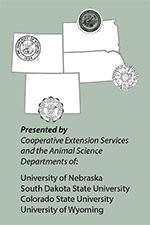Long-range Weather Outlook
Brian Bledsoe offers his take on long-term weather outlook.
TV weathercaster and private consultant Brian Bledsoe was back by popular demand. Well-received at the last Range Beef Cow Symposium (RBCS) two years ago, the Colorado-based meteorologist was invited to speak again at the 2017 event convened Nov. 28-30 in Cheyenne, Wyo.
It’s not that Bledsoe tells farmers and ranchers what they would most like to hear. He shares his long-term weather expectations, whether favorable or foreboding, in hope that agricultural producers will prepare for what likely lies ahead.
Speaking to an audience consisting primarily of ranchers from the High Plains, Bledsoe said the tools of his trade suggest much of that region, during coming months, will be shy on precipitation.
Displaying maps representing various forecasting models, he commented on a particular image where, colored in blue, areas of the United States most likely to receive favorable moisture were shown — mainly the Northwest and upper Midwest.
“If you live in the blue, Yay!” cheered Bledsoe. “If you live in the brown, well, that sucks.”
Bledsoe was referring to large map portions colored in brown, indicating that dry conditions are expected in much of cow country, especially on the Western Plains and across the Southwest from Texas to southern California. Driving the forecast is the return of La Niña.
“Right now, the computer models are forecasting a continued weak to slightly moderate La Niña,” stated Bledsoe, referring to the weather-influencing cooling of equatorial Pacific Ocean waters.
While no two La Niña events are exactly alike, Bledsoe thinks this one is influencing a trend toward dry conditions that could persist through spring and into summer. Some variability is likely, but forecast models suggest “plenty of brown” on the U.S. map through much of the summer. On the Plains, he expects it to be driest in southern portions.
“The farther north you are, the less dry you’re likely to be. Notice I said ‘less dry,’” warned Bledsoe. “I’d be cautious about overextending myself if I were operating on the Plains. Dust off your drought plan — pun intended.”
Bledsoe said being “in the brown” might not be so bad when producers know that pretty dry conditions could last awhile — maybe even six to eight months — and use that information to advantage.
Editor’s Note: This summary was written under contract or by staff of the Angus Journal®, which retains the copyright. To request to reprint this article, contact Shauna Rose Hermel, editor, at 816-383-5270. PowerPoints are posted with permission of the presenter and may not be reproduced in whole or in part without the express permission of the presenter. Angus Journal claims copyright to this website as presented. We welcome educational venues and cattlemen to link to this site as a service to their audience.
The Angus Journal's coverage of the event is made possible in collaboration with the event committee. For questions about this site, or to notify us of broken links, click here. Look for additional coverage in the Angus Journal, the Angus Beef Bulletin, the Angus Journal Daily, the Angus Beef Bulletin EXTRA and The Angus Report.


